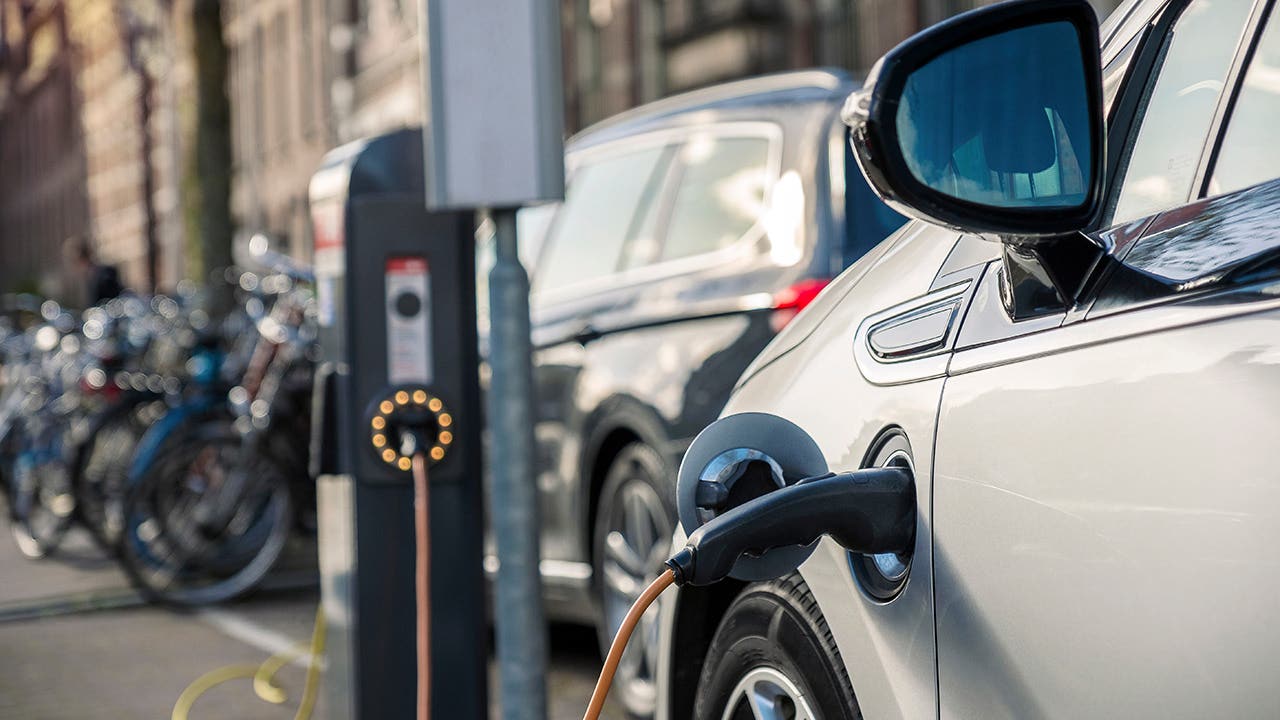Gas vs. electric vehicles: Which is cheaper to own?

The Bankrate promise
At Bankrate, we strive to help you make smarter financial decisions. To help readers understand how insurance affects their finances, we have licensed insurance professionals on staff who have spent a combined 47 years in the auto, home and life insurance industries. While we adhere to strict , this post may contain references to products from our partners. Here's an explanation of . Our content is backed by Coverage.com, LLC, a licensed entity (NPN: 19966249). For more information, please see our .
With the average cost of owning and operating a new vehicle in 2023 now at $12,182 annually, drivers may be feeling the pinch. This is a sharp increase from 2022 when the average yearly cost was only $10,728. Rising costs, along with concerns like reducing gas consumption and decreasing your carbon footprint, can make switching to an electric vehicle enticing. Incentives from federal and state governments might just add to the appeal. But will driving an electric vehicle (EV) actually help save both money and the environment? Unlike other vehicles, the true cost of an electric car isn’t straightforward. Here are some key things to weigh if you’re thinking about buying an EV.
The cost of going green: EV vs. gas car prices
If you’re exploring the purchase of an electric car, you may have already realized how different the process is compared to buying a gas-powered car. When choosing a vehicle, instead of considering miles per gallon and fuel tank size, you’ll need to determine how much range you need for daily driving. You can look into a vehicle’s total range, or for comparison purposes, its miles per gallon of gasoline-equivalent (MPGe). You might also want to get a feel for the cost per kilowatt per hour (kWh) to recharge an EV at home or at a public charging station.
On top of the purchase price and charging costs, car insurance is mandatory in almost every state regardless of whether you drive an electric or gas-powered car. What many drivers may not realize is that car insurance for electric vehicles can be substantially more expensive. Higher insurance costs are primarily due to more expensive parts and the specialized labor required to repair electric vehicles.
The chart below details the manufacturer’s suggested retail price (MSRP) of several vehicle models, plus the range or mileage of each, as well as average annual car insurance costs per data from Quadrant Information Services:
| Vehicle (2023 model) | Base MSRP (electric models are shown without the federal tax credit of $7,500) | EPA estimated range or fuel efficiency | Average annual cost for full coverage car insurance | |
|---|---|---|---|---|
| Electric | Chevy Bolt | $26,500 | 120 MPGe / 259 mi total range | $2,007 |
| Nissan Leaf | $28,040 | 111 MPGe / 149 mi total range | $2,024 | |
| Tesla Model S | $74,990 | 120 MPGe / 405 mi total range | $2,804 | |
| Tesla Model X | $79,990 | 102 MPGe / 348 mi total range | $4,364 | |
| Tesla Model 3 | $40,240 | 132 MPGe / 272 mi total range | $2,577 | |
| Toyota Prius | $28,545 | 52 / 52 MPG | $2,117 | |
| Gas-powered | Ford F-150 | $34,585 | 25 / 25 MPG | $1,753 |
| Honda Civic | $23,750 | 44 / 51 MPG | $1,963 | |
| Nissan Altima | $25,630 | 27 / 39 MPG | $2,208 | |
| Toyota Camry | $26,230 | 22 / 33 MPG | $1,819 |
Incentives and rebates
A major perk promoted by car manufactures when buying new all-electric and plug-in hybrid vehicles is the federal tax credit. While the maximum credit amount is $7,500, the actual amount will vary depending on the battery’s capacity and other stipulations. For example, if you lease a qualified vehicle, this credit will go to the lessor instead of you.
Keep in mind that every car manufacturer has a limit on these credits, and they change all the time. Today, buyers of Tesla or Chevrolet models are no longer eligible for this benefit. A current list of eligible vehicles and the maximum credit amounts can be found through the U.S. Department of Energy.
State and local incentives for purchasing an electric vehicle exist, as well. The National Conference of State Legislatures provides details on all the different incentives in each state for electric vehicle buyers. Some benefits and extra incentives include rebates on home energy costs, help with financing home charger installations, HOV lane exemptions with appropriate vehicle tags and more. Some electric utility companies also offer rebates and incentives for owning and charging an electric vehicle at home.
When it comes to buying a new electric vehicle, there are also unique financing options available. Green auto loans tailored specifically for electric and fuel-efficient vehicles take into account the higher purchase price of these vehicles by offering buyers extra benefits. This could include lower interest rates and longer repayment terms, making the monthly payment more affordable.
Are EVs cheaper than gas?
A major factor to think through when considering an electric vehicle is the cost of charging an EV compared to filling a car up with gas. Charging an EV at home with a Level 2 charger can cost between $0.12 to $0.24 per kWh, which translates to $3 to $6 for a full charge that can typically go 200-plus miles.
This is considerably cheaper than gas for most drivers. Using public fast chargers costs more, averaging around $0.30 per kWh, with a full charge totaling $15 to $25. While more expensive than home charging, this is still likely cheaper than a comparable gas fill-up for over 200 miles of range. Overall, EV drivers will typically spend less on electricity than gas, saving money in the long run, especially with home charging.
| Cost to refuel or recharge | Miles traveled | Total cost for 200 mi |
|---|---|---|
| $3.77 per gallon of gas | 200 miles @ 24.9 MPG | 8 gallons of gas = $30.16 |
| $3–$6 for regular charging | 200+ miles | 1 charge = $3–$6 |
| $15–$25 for fast charging | 200+ miles | 1 charge = $15–$25 |
Hidden costs of an electric vehicle
You might have made plans to buy or finance your new electric car and have an estimate of what your car insurance premium might be, but the costs of an electric vehicle don’t end there. Here are some of the hidden costs that can come with owning an electric vehicle.
Depreciation of electric vehicles
Within its first year, a brand-new car’s value can depreciate up to 20 percent. For an electric car, this can be even greater, depending on how quickly technology has improved. Newer cars could have longer range and improved battery life, making older models obsolete.
The car’s make and model matter, too. A comparison by CarEdge found that, after five years, a Tesla Model 3 maintained around 71 percent of its resale value, while a Nissan Leaf only maintained 55 percent. A Toyota Camry, on the other hand, maintained 76 percent of its resale value.
Battery degradation in electric vehicles
When it comes to electric vehicles, there’s another problem car owners can run into as the car gets older: battery degradation. A gas-powered car’s tank doesn’t get smaller as it gets older, but as an electric car ages, its battery range dwindles, decreasing the maximum amount of miles you can drive before it needs to be recharged. While many factors can impact battery lifespan, from improper charging to cold weather conditions, it’s unavoidable that an electric vehicle’s battery will not always have the same range as it did when it was new. And, just like with the battery on a gas-powered vehicle, you will eventually have to replace it. More on that expense in a moment.
Maintenance for electric vehicles
All-electric vehicles have fewer moving parts compared to gas-powered vehicles, which may lead to the assumption that they are cheaper to maintain. In some respects, this is true — electric vehicles don’t require oil changes or regular tuneups, and because of regenerative braking, brake systems may also last longer. Further, a study by AAA found that it only costs an estimated $949 annually to service an electric car versus $1,279 for a gas vehicle.
Instead, one of the largest costs associated with electric vehicles may be its eventual battery replacement. Those buying a brand-new EV may not need to worry about this for several years, but those wanting to go the pre-owned route may see this cost come up sooner rather than later. Green Cars estimates that the average cost of replacing the battery is between $5,000 to $15,000, even before labor.
However, it can help to know that modern batteries can last up to 10 years or more, depending on the car itself, how it’s driven, how it’s charged and more. Additionally, Green Cars reports that many automakers have an eight- to 10-year or 100,000-mile warranty on their electric car batteries.
Charging electric vehicles
How to charge an electric vehicle may be the first concern of any prospective electric vehicle owner. Fully charging an electric car could take anywhere from 30 minutes to a few hours, and whether you charge at home or at a public charging station, there may be higher rates during peak hours. For those who rent or live in a townhouse or condominium where installing an at-home charger isn’t feasible, owning an electric vehicle comes with more challenges for this reason.
But if you’re able to charge from home, installing an EV charger is convenient — although it does add another cost to your EV ownership. You’ll typically need to purchase a separate charger and hire an electrician to retrofit your home. Additionally, you’ll want to do a calculation to accurately estimate the total cost for your electric vehicle to see if it offsets the cost of fueling your current car. The first step starts with knowing how much your electricity costs per kilowatt during peak and off-peak hours. As mentioned earlier, some electric utility companies do offer incentives and rebates for EV owners who charge their vehicles at home, so you may want to check with your electricity company to see if any cost savings are available.
Tools to help you calculate the cost of owning an electric vehicle
Part of buying an electric vehicle is taking the time to understand whether or not it fits your needs and lifestyle. Before you decide to make a switch, here are some resources to help you calculate the cost of owning an electric vehicle:
- FuelEconomy.gov: Created by the Environmental Protection Agency, this website allows you to compare up to four vehicles based on EPA fuel economy, annual fuel cost, tank cost, tank size and more.
- Alternative Fuels Vehicle Cost Calculator: This tool, created by the U.S. Department of Energy, helps drivers compare up to eight vehicles and takes into consideration how the vehicle will be used, such as the average daily driving distance and types of roads the vehicle will be most commonly driven on.
- Carbon Counter: MIT’s Carbon Counter is useful for drivers who want to see what their carbon output might be depending on the car they choose to drive.
Should you buy an electric vehicle?
Given the detrimental impact gas-powered cars have on the environment, it’s no wonder that many drivers are switching to electric vehicles. California has even announced a plan to restrict and ban the sale of new cars powered by internal combustion engines by 2035, a measure that could be adopted by other states and even at the national level at some point.
Still, buying an electric vehicle is a personal choice. EVs may require adjusting your routine, especially if charging options are limited where you live. Costs like insurance, maintenance and home charging can add up, too. But if you can benefit from the convenience of an EV, capitalize on available incentives and want to reduce your carbon footprint, going electric may be worth considering. If an EV isn’t right for you, economical and eco-friendly gas-powered and hybrid models are still great options, with carmakers expanding their lineups. And if you’re unsure about a fully electric vehicle, a plug-in hybrid could be the perfect compromise.
Methodology
Bankrate utilizes Quadrant Information Services to analyze 2023 rates for all ZIP codes and carriers in all 50 states and Washington, D.C. Quoted rates are based on a 40-year-old male and female driver with a clean driving record, good credit and the following full coverage limits:
- $100,000 bodily injury liability per person
- $300,000 bodily injury liability per accident
- $50,000 property damage liability per accident
- $100,000 uninsured motorist bodily injury per person
- $300,000 uninsured motorist bodily injury per accident
- $500 collision deductible
- $500 comprehensive deductible
To determine minimum coverage limits, Bankrate used minimum coverage that meets each state’s requirements. Our base profile drivers commute five days a week, drive 12,000 miles annually and own a 2021 model year of one of the following vehicles:
- Chevy Bolt
- Ford F-150
- Honda Civic
- Nissan Altima
- Nissan Leaf
- Tesla Model S
- Tesla Model X
- Tesla Model 3
- Toyota Camry
- Toyota Prius
These are sample rates and should only be used for comparative purposes.
Related Articles



